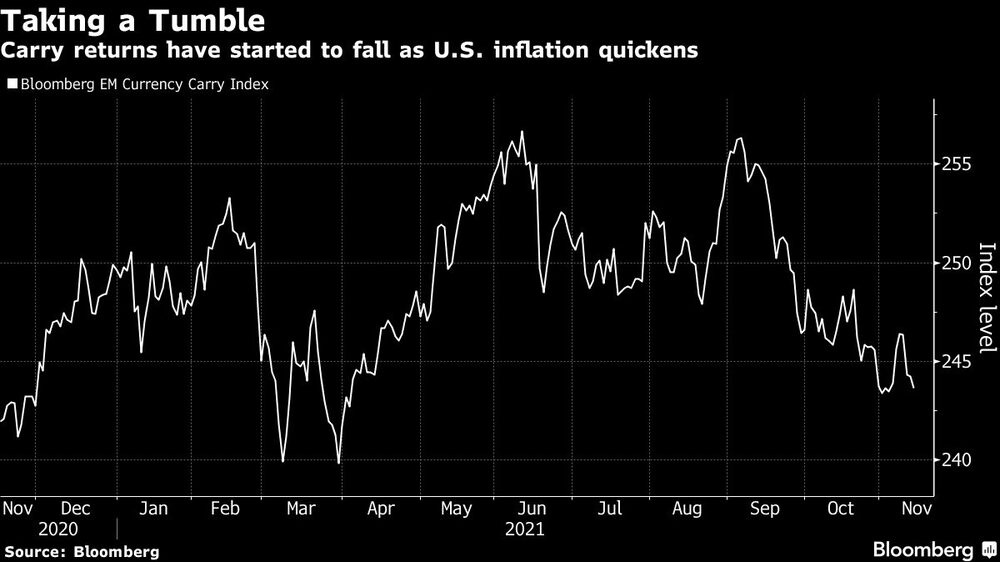Bloomberg — A short-lived reprieve for emerging-market carry trades funded in dollars looks to be over, with an upsurge in U.S. inflation making the outlook increasingly treacherous.
A Bloomberg index of these bets has dropped more than 4% in the past two months, the biggest slide since March 2020 for a strategy of borrowing in the greenback and investing in developing-nation currencies. The quickest U.S. inflation in three decades is putting pressure on the Federal Reserve to tighten, raising the prospect of higher costs for dollar borrowers, and less extra yield -- or carry.
It’s a speedy about-face for traders, who just two months ago were taking comfort in the Fed’s dovish messaging around gradual pace of tightening, and were using the opportunity to pile into carry trades. Many of these bets are now coming undone due to the growing concern about inflation, and about whether central banks will have to play catch up with aggressive hikes.

“Sharply higher-than-expected inflation readings in the U.S. and China will play havoc with the narrative that inflation pressures are transitory,” said Mitul Kotecha, chief emerging markets Asia and Europe strategist at TD Securities in Singapore. “This bodes badly for EM carry trades in the near term as it reduces the relative yield gap.”
A tightening in global liquidity conditions due to the Fed tapering its asset purchases may also raise some obstacles for emerging-market carry, Kotecha said.
Traders could turn to the euro and yen for cheaper funding costs. Both currencies are among the worst performers in the Group-of-10 space so far this quarter, with the Bank of Japan and European Central Bank expected to maintain an accommodative stance.
The losses in the Bloomberg index of emerging-market carry trades since the end of August come after it bounced up by 1.5% that month. The gauge, which covers eight currencies including the Brazilian real, Mexican peso and Indian rupee, is heading for a second annual loss.

Among the worst performers over the past two months, a trade of borrowing dollars and buying the Turkish lira has lost 11%, while investments in the South African rand or Hungarian forint have both dropped more than 6%. On the upside, putting funds in the Argentine peso has returned 7%.
There’s at least some prospect emerging-market central banks will raise interest rates fast enough to ensure a sufficient yield premium to improve carry returns. Investors may get further guidance about that this week with policy decisions from Turkey, Indonesia, Philippines and Hungary.
Picking Favorites
The outlook for carry looks better for currencies in the Americas, and in the Europe, Middle East and Africa region than it does for Asia, according to Bloomberg Intelligence.
The lira, Russian ruble, Mexican peso and rand are likely to generate the best returns, while the rupiah and rupee are less attractive, chief emerging-market credit strategist Damian Sassower in New York, wrote in a research note this month.
“Interest rates are rising more rapidly across Latin America and EMEA,” he said. “Asian currencies have lost their luster in 2021, as the short-dated carry embedded within high-yielding economies continues to diminish.”
Here are some of the major events and data to look out for this week:
- Central banks in Turkey, Indonesia, Philippines and Hungary will review policy settings
- Indonesia and the Philippines will probably keep rates on hold as officials are focused on supporting the growth recovery, according to Bloomberg Economics
- Turkey’s decision will be in focus after two consecutive surprise rate cuts since September carried the lira’s year-to-date depreciation against the dollar to more than 20%
- Hungary’s central bank is under pressure to boost the size of monthly rate increases as inflation surges. The magnitude of rate hikes were reduced to 15 basis points in September and October after 30 basis-point steps in each of the preceding three months
- Gross domestic product data are due from countries including Russia, Thailand, Colombia and Chile

